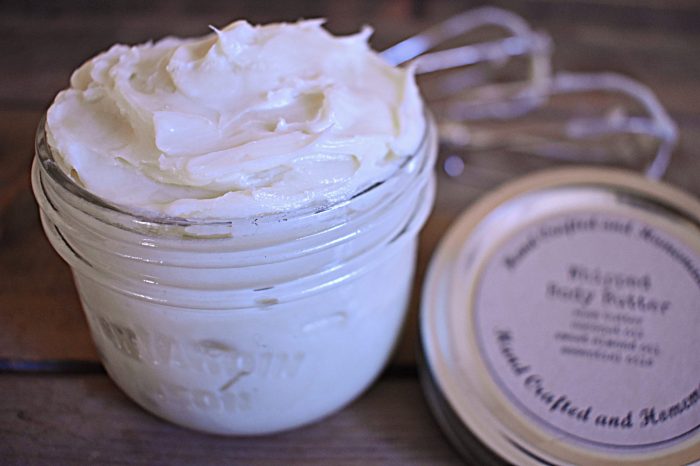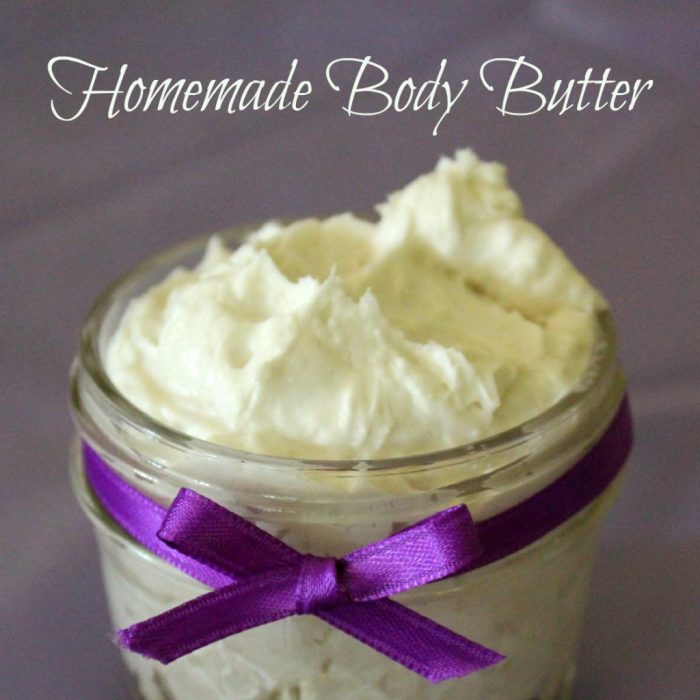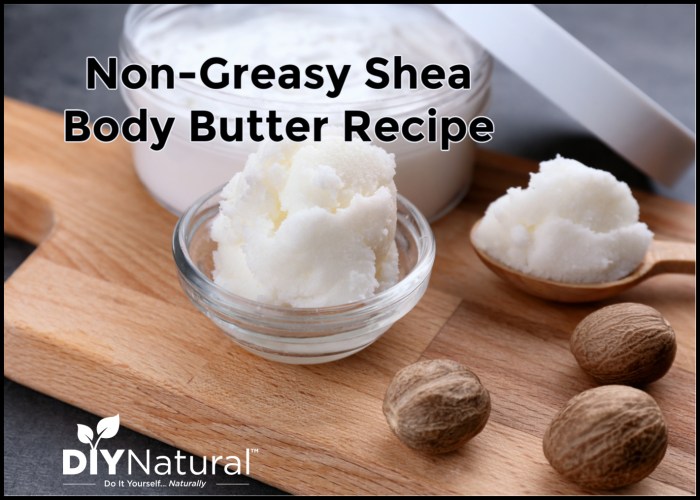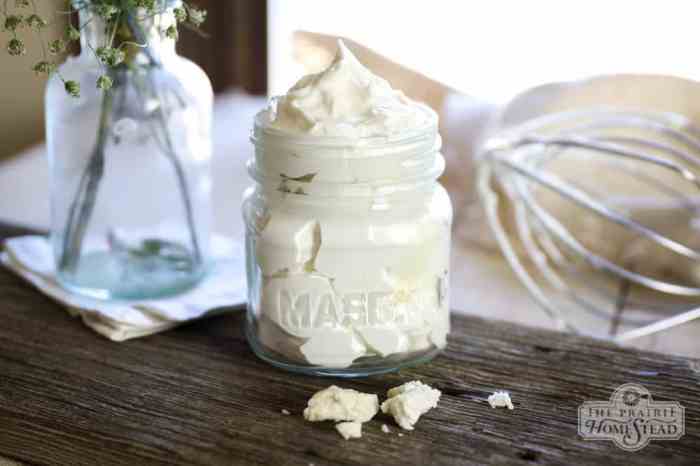Body butter recipe is a journey of self-care, blending luxurious ingredients to create a nourishing and fragrant experience. It’s a delightful blend of science and artistry, where you become the alchemist, transforming simple ingredients into a moisturizing masterpiece.
This guide will walk you through the basics of body butter, from understanding the benefits and key ingredients to crafting your own unique recipe. We’ll explore the different types of butters, the magic of essential oils, and how to customize your creations to suit your individual needs and preferences.
Introduction to Body Butter

Body butter is a rich, creamy moisturizer that is typically made with a combination of butters, oils, and other nourishing ingredients. It is designed to deeply hydrate and nourish the skin, leaving it feeling soft, smooth, and supple. Body butter offers a range of benefits for your skin.
Benefits of Using Body Butter
Body butter provides several advantages for your skin, including:
- Deep Hydration:Body butter’s rich, emollient texture effectively seals in moisture, preventing dryness and dehydration.
- Nourishment:The combination of butters and oils in body butter delivers essential nutrients to the skin, promoting a healthy and vibrant appearance.
- Skin Protection:Some body butters contain ingredients with antioxidant properties that help protect the skin from environmental damage caused by free radicals.
- Improved Skin Texture:Regular use of body butter can improve skin texture, making it feel smoother and softer.
- Reduced Inflammation:Certain ingredients in body butter, such as shea butter or aloe vera, possess anti-inflammatory properties that can soothe irritated or inflamed skin.
Key Ingredients in Body Butter
Body butter is typically composed of a blend of key ingredients that contribute to its unique properties.
- Butters:The foundation of body butter lies in butters like shea butter, cocoa butter, mango butter, and kokum butter. These butters provide rich emollients, leaving the skin feeling soft and supple.
- Oils:Body butter often includes oils such as coconut oil, jojoba oil, argan oil, or sweet almond oil. These oils add moisture, nourishment, and sometimes specific benefits depending on the oil used.
- Essential Oils:Some body butter recipes incorporate essential oils like lavender oil, rose oil, or tea tree oil. These oils provide aromatherapy benefits and can enhance the fragrance of the body butter.
- Other Ingredients:Depending on the specific recipe, body butter may include additional ingredients like beeswax, vitamin E, or aloe vera. These ingredients can contribute to the texture, benefits, and overall quality of the body butter.
Basic Body Butter Recipe

This simple and easy-to-follow recipe will guide you through the process of making your own nourishing body butter. With just a few basic ingredients and a little time, you can create a luxurious and hydrating product that will leave your skin feeling soft and smooth.
Ingredients
The ingredients for this recipe are readily available and can be found at most grocery stores or online retailers.
The quantities listed below are for a small batch of body butter. You can easily scale the recipe up or down as needed.
- 1/2 cup (1 stick) unsalted butter, softened
- 1/4 cup coconut oil, melted
- 1/4 cup shea butter, melted
- 1/4 cup cocoa butter, melted
- 1 teaspoon vitamin E oil (optional)
- Essential oil of your choice (optional)
Steps
The steps involved in creating body butter are straightforward and can be completed in a short amount of time.
- In a large bowl, combine the softened butter, melted coconut oil, melted shea butter, and melted cocoa butter.
- Use a whisk or electric mixer to blend the ingredients together until smooth and creamy.
- Add the vitamin E oil (optional) and essential oil of your choice (optional) to the mixture.
- Continue mixing until the oils are evenly distributed.
- Pour the body butter mixture into a clean jar or container.
- Store the body butter in a cool, dark place.
Choosing Ingredients
The foundation of any great body butter lies in the selection of its key ingredients: the butters themselves. Each butter brings unique properties to the table, influencing the texture, scent, and overall benefits of your final product. Let’s explore some of the most popular choices and their unique characteristics.
Types of Butters
The following are some of the most common butters used in body butter recipes:
- Shea Butter: Renowned for its rich, creamy texture and exceptional moisturizing properties. Shea butter is packed with vitamins A, E, and F, which contribute to skin nourishment, healing, and protection against environmental damage. Its anti-inflammatory properties can soothe irritated skin and reduce the appearance of blemishes.
- Cocoa Butter: Known for its luxurious feel and delicate chocolate aroma. Cocoa butter is a good source of antioxidants and fatty acids, which help to improve skin elasticity, reduce wrinkles, and promote a youthful glow. It also has a high melting point, making it a good choice for body butters that are intended to be used in warmer climates.
- Mango Butter: A lesser-known but increasingly popular choice for its unique properties. Mango butter is a good source of vitamins A, C, and E, and it is rich in antioxidants. It has a lightweight texture that absorbs quickly into the skin, leaving a soft, non-greasy finish.
Mango butter is also known for its ability to soothe and heal irritated skin, making it a good choice for people with sensitive skin.
- Kokum Butter: Extracted from the seeds of the Garcinia indica fruit, kokum butter is a unique addition to body butter recipes. Its rich, creamy texture melts beautifully on the skin, providing deep hydration. Kokum butter is also known for its anti-inflammatory and antioxidant properties, making it a good choice for people with sensitive or acne-prone skin.
Choosing the Right Butter
The best butter for your body butter recipe will depend on your desired skin benefits and the overall texture you’re aiming for.
- For deeply moisturizing and nourishing properties, shea butter is a top choice. Its rich texture provides long-lasting hydration and its anti-inflammatory properties can help to soothe irritated skin.
- If you’re looking for a butter that will help to improve skin elasticity and reduce the appearance of wrinkles, cocoa butter is a good option. Its antioxidant properties can help to protect the skin from environmental damage and its high melting point makes it suitable for use in warmer climates.
- For a lighter, more easily absorbed butter, mango butter is a good choice. Its unique properties make it a good option for people with sensitive skin and it is known for its ability to soothe and heal irritated skin.
- For a luxurious, deeply moisturizing experience, consider incorporating kokum butter. Its creamy texture melts beautifully on the skin, leaving it feeling soft and supple. Its anti-inflammatory properties make it a good choice for people with sensitive or acne-prone skin.
Blending Butters
Many body butter recipes call for a blend of different butters, allowing you to customize the texture, scent, and benefits of your final product. For example, a blend of shea butter and cocoa butter can provide both deep hydration and antioxidant protection.
Blending mango butter with shea butter creates a lighter, more easily absorbed butter that is still deeply moisturizing.
“Remember, the best body butter is the one that meets your individual needs and preferences.”
Adding Essential Oils and Extracts: Body Butter Recipe
Essential oils and extracts are concentrated plant essences that can add a delightful fragrance, therapeutic benefits, and a touch of luxury to your body butter. They offer a wide range of properties that can cater to various skin types and concerns.
Benefits of Essential Oils and Extracts
Essential oils and extracts are known for their various therapeutic benefits, making them a popular addition to body butter. They can enhance the sensory experience, promote relaxation, and address specific skin concerns.
- Aromatic Benefits:Essential oils can provide a pleasant and calming fragrance, creating a spa-like experience during application.
- Skin-Soothing Properties:Certain essential oils and extracts possess anti-inflammatory and antioxidant properties, which can help soothe irritated skin, reduce redness, and promote healing.
- Hydration and Nourishment:Some essential oils, like lavender and chamomile, can help retain moisture and nourish the skin, leaving it feeling soft and supple.
- Balancing Effects:Essential oils can help balance skin oil production, making them beneficial for both oily and dry skin types.
Choosing Essential Oils and Extracts
Selecting the right essential oils and extracts for your body butter is crucial, as they can significantly impact the overall benefits and effectiveness of the product.
- Skin Type:Consider your skin type when choosing essential oils. For example, lavender and chamomile are generally well-suited for sensitive skin, while tea tree oil is effective for oily and acne-prone skin.
- Skin Concerns:Identify any specific skin concerns you want to address, such as dryness, irritation, or blemishes. Essential oils and extracts can be chosen based on their known properties to address these concerns.
- Personal Preferences:Ultimately, the choice of essential oils and extracts comes down to personal preference. Select scents and properties that you find appealing and that align with your desired benefits.
Adding Essential Oils and Extracts to Body Butter
The method of adding essential oils and extracts to body butter is crucial to ensure their effectiveness and safety.
General Guideline:Use a maximum of 1% to 2% essential oils or extracts in your body butter formula. This concentration provides a pleasant scent and therapeutic benefits without overwhelming the skin.
Get the entire information you require about beefaroni recipe on this page.
- Add at the End:Essential oils and extracts are volatile and can be easily damaged by heat. Therefore, add them to your body butter after it has cooled down to room temperature.
- Mix Thoroughly:Gently stir the essential oils or extracts into the body butter until they are evenly distributed throughout the product.
- Patch Test:Before applying the body butter to your entire body, perform a patch test on a small area of skin to ensure you don’t have any adverse reactions to the essential oils or extracts.
Variations and Customization

The beauty of body butter recipes lies in their versatility. You can easily adjust the base recipe to suit your preferences, skin type, and desired effects. By experimenting with different scents, colors, and textures, you can create a truly personalized body butter that nourishes and pampers your skin.
Adding Scents and Colors
Scents play a crucial role in enhancing the sensory experience of using body butter. You can infuse your body butter with a wide range of aromas, from calming lavender to invigorating citrus. To add fragrance, essential oils are a popular choice.
They not only provide a delightful scent but also offer potential therapeutic benefits. For example, lavender oil is known for its calming properties, while tea tree oil is recognized for its antimicrobial effects. However, it’s important to use essential oils in moderation, as they can be potent and potentially irritating to sensitive skin.
Always dilute them in a carrier oil like coconut oil or shea butter before adding them to your body butter.For a touch of color, you can use natural ingredients like beetroot powder for a vibrant pink hue or turmeric powder for a warm yellow shade.
Just remember to test the color on a small area of skin first to ensure it doesn’t cause any reactions.
Adding Ingredients for Specific Skin Benefits
Body butter can be further customized by incorporating additional ingredients that address specific skin concerns.
- Honey: A natural humectant that attracts and retains moisture, making it ideal for dry skin. It also possesses antibacterial and anti-inflammatory properties, soothing irritated skin.
- Aloe Vera: Known for its soothing and healing properties, aloe vera gel can help to reduce inflammation and redness. It is also a natural moisturizer, making it suitable for all skin types.
- Vitamin E: A powerful antioxidant that protects the skin from damage caused by free radicals. It can help to improve skin elasticity and reduce the appearance of wrinkles and scars.
Adjusting for Different Seasons and Climates
The consistency of your body butter can be adjusted to suit different seasons and climates. For warmer weather, you might prefer a lighter, more easily absorbed formula. You can achieve this by using a higher proportion of liquid oils, such as almond oil or grapeseed oil, in your recipe.
In colder climates, a thicker, more emollient body butter might be more suitable. You can achieve this by increasing the proportion of butters like shea butter or cocoa butter.
For example, during the summer months, you might use a ratio of 1:1 shea butter to almond oil. During the winter, you could increase the proportion of shea butter to 2:1.
Storage and Shelf Life

Storing your homemade body butter correctly is crucial to maintain its quality and prevent spoilage. Proper storage ensures that your body butter stays fresh, smooth, and effective for as long as possible.
Storage Methods
The most effective way to store your body butter is in an airtight container, such as a glass jar or a plastic container with a tight-fitting lid. This helps to prevent air and moisture from entering, which can cause oxidation and spoilage.
- Store your body butter in a cool, dark place, such as a pantry or a cabinet away from direct sunlight and heat.
- Avoid storing your body butter in the bathroom, as the high humidity can promote mold growth.
- If you live in a warm climate, consider storing your body butter in the refrigerator to help extend its shelf life.
Shelf Life, Body butter recipe
The shelf life of homemade body butter can vary depending on the ingredients used and storage conditions. Generally, homemade body butter can last for up to 6 months if stored properly.
- Body butter with a high concentration of shea butter or cocoa butter tends to have a longer shelf life.
- Body butter containing essential oils or other volatile ingredients may have a shorter shelf life.
Extending Shelf Life
- Store your body butter in a cool, dark place to minimize oxidation and prevent spoilage.
- Use a clean spatula or spoon to scoop out the body butter to avoid contaminating the entire batch.
- Avoid using body butter that has an off smell or appearance, as this could indicate spoilage.
Safety Considerations
While crafting your own body butter can be a rewarding experience, it’s essential to prioritize safety. Some ingredients might pose potential risks, and proper handling practices are crucial to ensure a safe and enjoyable experience.
Patch Testing
Before applying body butter to your entire body, it’s highly recommended to perform a patch test. This involves applying a small amount of the body butter to a discreet area of your skin, like the inside of your elbow or behind your ear.
Wait for 24-48 hours to observe any reactions.
Patch testing helps identify potential allergies or sensitivities to any ingredients in the body butter.
If you notice any redness, itching, or irritation, discontinue use and consult a dermatologist.
Wrap-Up
With a little experimentation and creativity, you can craft body butters that are as unique as you are. Whether you’re seeking to soothe dry skin, indulge in a luxurious treat, or simply enjoy the therapeutic process of creating something beautiful, body butter making offers a rewarding and enriching experience.
